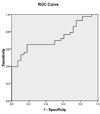Use of bedside ultrasound to assess degree of dehydration in children with gastroenteritis
- PMID: 21040104
- PMCID: PMC3058669
- DOI: 10.1111/j.1553-2712.2010.00873.x
Use of bedside ultrasound to assess degree of dehydration in children with gastroenteritis
Abstract
Objectives: Prospectively identifying children with significant dehydration from gastroenteritis is difficult in acute care settings. Previous work by our group has shown that bedside ultrasound (US) measurement of the inferior vena cava (IVC) and the aorta (Ao) diameter ratio is correlated with intravascular volume. This study was designed to validate the use of this method in the prospective identification of children with dehydration by investigating whether the IVC/Ao ratio correlated with dehydration in children with acute gastroenteritis. Another objective was to investigate the interrater reliability of the IVC/Ao measurements.
Methods: A prospective observational study was carried out in a pediatric emergency department (PED) between November 2007 and June 2009. Children with acute gastroenteritis were enrolled as subjects. A pair of investigators obtained transverse images of the IVC and Ao using bedside US. The ratio of IVC and Ao diameters (IVC/Ao) was calculated. Subjects were asked to return after resolution of symptoms. The difference between the convalescent weight and ill weight was used to calculate the degree of dehydration. Greater than or equal to 5% difference was judged to be significant. Linear regression was performed with dehydration as the dependent variable and the IVC/Ao as the independent variable. Pearson's correlation coefficient was calculated to assess the degree of agreement between observers.
Results: A total of 112 subjects were enrolled. Seventy-one subjects (63%) completed follow-up. Twenty-eight subjects (39%) had significant dehydration. The linear regression model resulted in an R² value of 0.21 (p < 0.001) and a slope (B) of 0.11 (95% confidence interval [CI] = 0.08 to 0.14). An IVC/Ao cutoff of 0.8 produced a sensitivity of 86% and a specificity of 56% for the diagnosis of significant dehydration. Forty-eight paired measurements of IVC/Ao ratios were made. The Pearson correlation coefficient was 0.76.
Conclusions: In this pilot study the ratio of IVC to Ao diameters, as measured by bedside US, was a marginally accurate measurement of acute weight loss in children with dehydration from gastroenteritis. The technique demonstrated good interrater reliability.
© 2010 by the Society for Academic Emergency Medicine.
Figures





References
-
- McConnochie K, Conners G, Lu E, Wilson C. How commonly are children hospitalized for dehydration eligible for care in alternative settings? Arch Pediat Adolesc Med. 1999;153(12):1233–1241. - PubMed
-
- McMillan JD, Feigin R, Warshaw J. Oski's Pediatrics: Principles and Practice. 3 edition. New York, NY: Lippincott Williams & Williams; 1999.
-
- Gorelick MH, Shaw KN, Murphy KO. Validity and reliability of clinical signs in the diagnosis of dehydration in children. Pediatrics. 1997;99(5):e6. - PubMed
-
- Steiner MJ, DeWalt DA, Byerley JS. Is this child dehydrated? JAMA. 2004;291(22):2746–2754. - PubMed
-
- Rudolph CR, Hostetter M, Lister G, Siegel N. Rudolph's Pediatrics. 21 edition. New York, NY: McGraw-Hill Companies; 2003.
Publication types
MeSH terms
Grants and funding
LinkOut - more resources
Full Text Sources
Other Literature Sources
Medical

